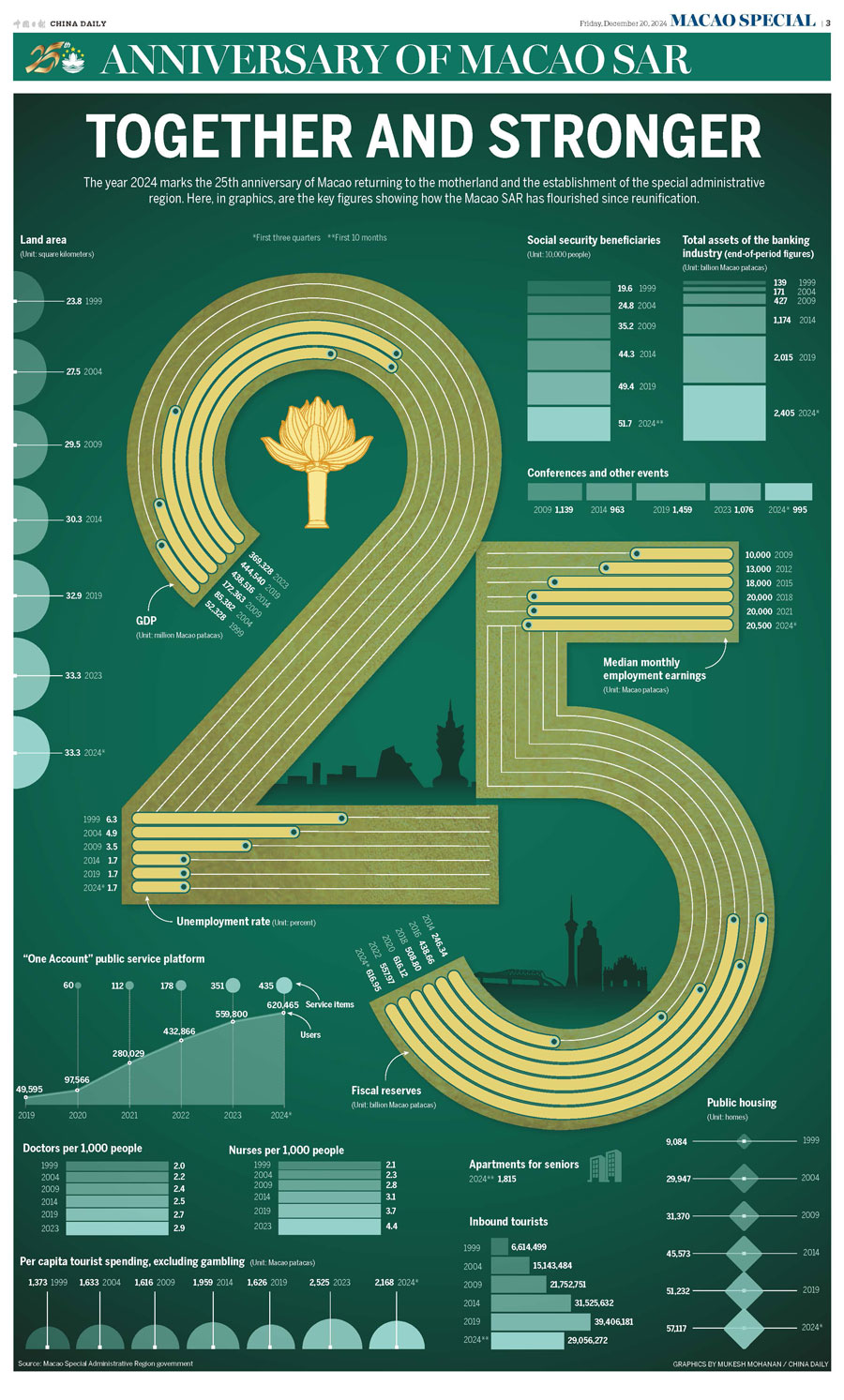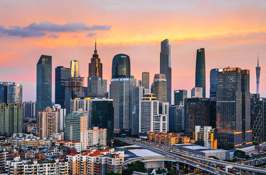Grand design highlights Macao's achievements
In celebration of the 25th anniversary of Macao's return to the motherland, English-language newspaper China Daily has published a special data page on Friday.
Featuring an artistic design, the graphics showcase the achievements that Macao has made over the past 25 years in the fields ranging from economy and livelihood to society and culture.
In the design, a large number "25" is embedded with the golden lotus flower logo, symbolic of the ever-prosperous Macao, as well as silhouettes of the SAR's iconic buildings such as the Ruins of St. Paul's, Macau Tower, Macau Science Center and the Macau Bridge, highlighting the 25th anniversary of Macao's return to the motherland.
The "25" design also incorporates data in four areas at six stages: Macao's GDP, overall unemployment rate, fiscal reserves, and median monthly employment earnings of Macao residents.
Data show that Macao's GDP jumped from 52.33 billion Macao patacas ($6.54 billion) in the year of its return in 1999 to 444.54 billion Macao patacas in 2019, and it reached 369.33 billion Macao patacas in 2023.
Macao saw a drop in unemployment after its return. The rate stood at 6.3 percent in 1999, fell to 1.7 percent in 2014, and remained at 1.7 percent in the first three quarters of this year.
In contrast, the median monthly employment earnings of the local residents reached 10,000 Macao patacas in 2009. In the first three quarters of this year, the figure reached 20,500 Macao patacas.
Its fiscal reserves reached 246.34 billion Macao patacas in 2014. In the first three quarters of this year, the figure jumped to 616.95 billion Macao patacas, demonstrating a rapid increase in fiscal strength and bullish development momentum of the Macao Special Administrative Region government.
In addition, the total assets of Macao's banking industry have rapidly grown from 139 billion Macao patacas at the end of 1999 to 2.41 trillion Macao patacas by the first three quarters of this year.
Since returning to the motherland, the Macao SAR government has improved the quality of life for residents in such sectors as employment, housing, education, healthcare, social security, assistance, and public services.
The past 25 years has been a period of the fastest development, highest quality, and strongest sense of happiness for residents in the history of Macao.
Data charts of different shapes and colors from dark to light show the changes in different fields such as healthcare, housing, and public services over the years.
The data show that 196,000 Macao residents benefited from social security in 1999. In the first 10 months of this year, the beneficiary number reached 517,000. In terms of healthcare, the doctor-to-1,000 population ratio and nurse-to-1,000 population ratio were 2.0 and 2.1 in 1999, respectively, reaching 2.9 and 4.4 in 2023. When it comes to public housing, 9,084 apartments were offered in 1999. The figure increased to 57,117 in the first three quarters of this year.
To improve public services, the SAR government launched the Macao "One Account" public service platform in 2019, benefiting 49,595 users that year. By the end of the third quarter of this year, the total number of users had reached 620,465. The "One Account" platform has also expanded its service items from 60 in 2020 to 435 currently.
Macao has a rich cultural heritage, well-developed tourism facilities, and festivals and events throughout the year, making it an appealing tourist attraction.
The in-depth integration of culture and technology has added momentum to the development of Macao's tourism industry. In 2023 and 2024, the SAR was awarded the "Best Convention City in Asia" and the "Best BT-MICE City" respectively, due to its outstanding performance in the convention and exhibition industry, and its achievements as a destination for business trips, as well as meetings, incentives, conferences and exhibitions.
It also earned the title of "Culture City of East Asia 2025" in an initiative jointly launched by China, Japan and South Korea. Via the Culture City of East Asia program, the three nations name one or two cities in each country each year to promote cultural exchanges and cooperation.
Data show that Macao received 6.61 million inbound tourists in 1999. From January to October this year, the number of inbound tourists exceeded 29.06 million.
The per capita tourist spending was 1,373 Macao patacas in 1999 and 2,168 Macao patacas in the first three quarters of this year.




 Print
Print Mail
Mail

